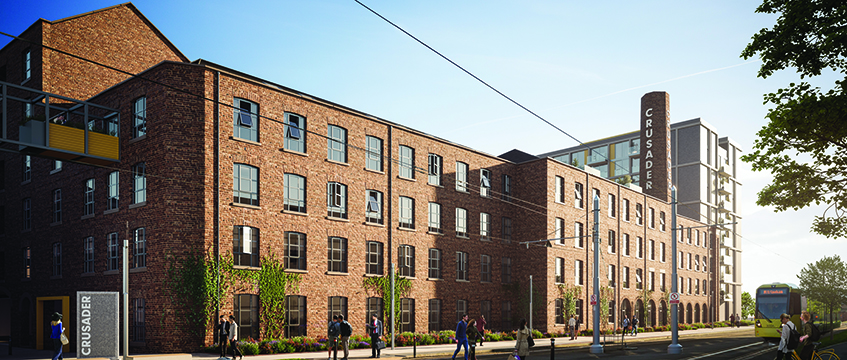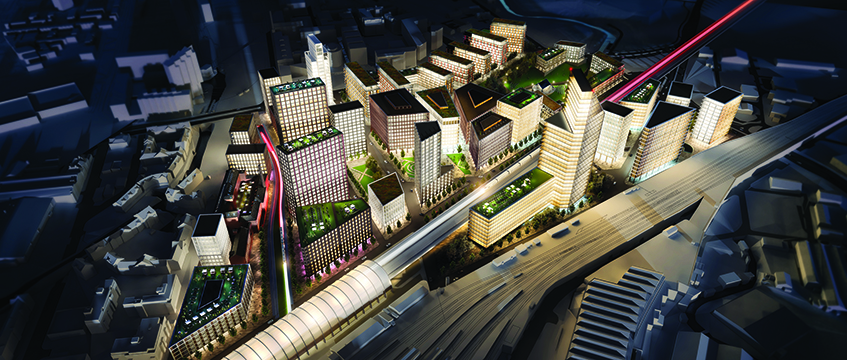The development of East Village, ‘Manchester’s King’s Cross’, has finally started, with Manchester City Council also approving a framework for the broader area.
Capital & Centric is the first developer to put a spade in the ground in the area, situated behind Piccadilly Station, which has the potential for more than 6m sq ft of high-density mixed-use development but has so far seen little activity.
East Village was outlined as a neighbourhood development opportunity in Manchester’s HS2 strategic regeneration framework (SRF) back in 2014, and the developer last week started construction on its £50m, 201-flat Crusader Mill residential development on Chapeltown Street, which is expected to complete in late 2019.
READ MORE: Capital & Centric puts locals first in Crusader Mill
The area was envisaged as a residential-led regeneration with small offices, shops, cafes and bars with public spaces reminiscent of The Lanes in Brighton or Soho Square in London.
Adam Higgins, co-founder of Capital & Centric, compared East Village to King’s Cross: “20 years ago, it didn’t add much to London, and look at it now. It’s fantastic. I think Manchester can very much do something similar.
It’s a one minute walk from the back of Piccadilly train station. How often does that happen, where you can buy sites and develop that close to stations?” – Adam Higgins, Capital & Centric
“It’s a one minute walk from the back of [Manchester] Piccadilly train station. How often does that happen, where you can buy sites and develop that close to stations?”
Once redeveloped, East Village will rival other parts of Manchester where connectivity is not as extensive, Higgins said.
“Areas such as Spinningfields on the other side of Manchester arguably start to look a little bit on the edge because there are no tram lines and there is no mainline railway station there.”
What happens next?
Manchester City Council last week approved a Strategic Regeneration Framework for Portugal Street East, next to Capital & Centric’s Crusader Mill scheme.
The framework outlines plans for about 1m sq ft of residential-led development across six sites.

The first phase of Portugal Street East is US developer Aecom Capital and joint venture partner Olympian Homes’ £150m PRS development. The scheme – Aecom’s first investment in Europe – includes 425 flats across two towers and is scheduled for completion at the end of 2021.
Olympian and Aecom, which is delivering 7.5m sq ft of development in the US, are the lead developers on the SRF for Portugal Street East, and said it presents an opportunity to create a new residential community within the city.
What’s happening elsewhere?
In line with that, Capital & Centric recently bought a 0.25-acre brownfield site on the corner of Adair Street and Great Ancoats Street for about £2m, which it will redevelop into a mixed-use scheme that will likely be residential or hotel-led.
With a hotel-led scheme, Higgins said, developers can ensure a mix of uses in the area to complement the residential side.
Capital & Centric expects to bring forward more detailed plans by this summer and start on the site next year.
Plans for the remaining sites are bare, but they are expected to be redeveloped from the second half of 2019.
We need other developers to follow suit and create inspiring architecture with life and soul, rather than simply designing by spreadsheet.” – Adam Higgins, Capital & Centric
Aeroworks, a 31,733 sq ft office on Adair Street that used to be an aircraft components factory, is the only site in the Portugal Street East scheme that the SRF plans to retain in the short-term, given its refurbishment following Epsilon’s purchase of the site in 2015.
Despite being one of the last areas within the Manchester ring road left to be developed, it is the first area visitors to the city see when they arrive at Piccadilly.
Higgins said: “This is ultimately the HS2 gateway to the city and is already many people’s first impression of Manchester coming in by train.
“We need other developers to follow suit and create inspiring architecture with life and soul, rather than simply designing by spreadsheet.”
Why has it taken so long?
East Village was one of the neighbourhoods identified in Manchester’s HS2 SRF in 2014, which outlined plans for the area around Piccadilly Station in the lead-up to HS2’s arrival.
However, developers prioritised other opportunities across the city, including U+I’s Mayfield, partly because of East Village’s location behind the train station, Higgins said.
But new opportunities are drying up and the council’s approval of the Portugal Street East framework is renewing interest in the area.
Higgins said Capital & Centric had waited for a decision on Portugal Street East for about 18 months before it could get going on plans for Adair Street, and others should follow.
Although the area is residential-led, the dearth of new commercial space around the city means East Village can expect commercial development to follow the residential schemes.
To send feedback, e-mail karl.tomusk@egi.co.uk or tweet @ktomusk or @estatesgazette











